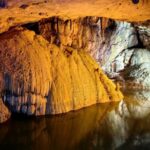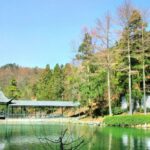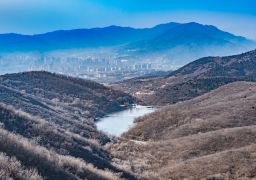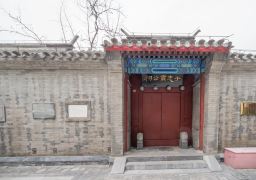The Gai Cang Mountain Scenic Area, with its developed tourist attractions, features the ‘East Sea Cloud Summit’. The main scenic spots include: Nan Yao Shuang Pu (South Waist Double Waterfalls), Tao Hua Ping (Peach Blossom Flat), Wu Ying Peak, Guan Yin Rock, Xian Ren Cave, He Long Tan (Black Dragon Pool), Shi Shi (Stone Chamber), Dong Di Shui (East Dripping Water), Xi Di Shui (West Dripping Water), Yue Bian Yin He Fei Pu (Moon Edge Milky Way Waterfall), Tao Wan (Tao Bay), Xian Ren Jia Qiao (Immortal’s Bridge), Jin Ji Rock, Nan Bei Xian Dong (South and North Fairy Caves), San Sheng Rock, Shi Chuan Tai (Stone Boat Terrace), Da Xiao Mo Zhu (Large and Small Pillars), Xian Ren Qi Ju (Immortal’s Chess Game), Yang Tian Lake, and Yun Feng An (Cloud Peak Temple), among others. From Ninghai East Station, take a 20-kilometer drive to Li Yang, then turn into the tea mountain forest and drive 10 kilometers north to reach the entrance of the Gai Cang Mountain Scenic Area – Tao Hua Keng, Nan Yao Shuang Pu. A hundred meters east from the highway, one can see the hidden waterfall deep within the high cliffs and canyons. Climbing up the newly built exploration trail on the west side of the waterfall, crossing the diagonal bridge over the stream, and walking north for more than 200 meters, one arrives at the majestic double waterfall. At the bottom of Tao Hua Ping, one reaches the scenery of Dong Di Shui and Xi Di Shui under Wu Ying Peak. Xi Di Shui cascades down like a curtain, and one can tour both inside and outside the curtain, above and below the waterfall. Looking southeast, one can see the beauty of Dong Di Shui Waterfall and the lush bamboo and trees of Tao Hua Ping. Walking up the stream from Dong Di Shui for several hundred meters, one arrives at the magnificent Yue Bian Yin He Fei Pu, also known as Cha Shan He Long Tan. The top of Yue Bian Waterfall is a flat slope with multiple dragon pools, which were the places for drought prayers in Xiangshan County and neighboring villagers in ancient times. On the west side of Yue Bian Yin He, Tao Wan is named after Tao Hongjing’s seclusion. This area is dominated by the evergreen ancient forest of East China Phoebe (Gai Cang Red Phoebe). Some trees grow together like four brothers or seven sisters, while others branch out like giant umbrellas, forming a forest of a single tree, which is astonishing. Heading west from Tao Wan is Jin Ji Rock, where the stories of Immortal’s Bridge and the Rooster’s Dawn are passed down among the people. Beyond Jin Ji Rock is Peng Keng, a thousand-acre bamboo sea. From Nan Yao, driving nearly 10 kilometers west along the highway, one reaches Nanfeng Gang, located between Nan Bei Xian Dong and Da Xiao Mo Zhu. To the east of Nanfeng Gang, the scenery includes Nan Dong, Bei Dong, San Sheng Rock, Shi Chuan Tai, and so on. Climbing 200 meters west from Nanfeng Gang, one reaches Xiao Mo Zhu, a scenic stone platform facing south. Climbing further up several hundred meters, one arrives at the main peak of Gai Cang Mountain – Da Mo Zhu. The mountain is adorned with stones like jade terraces and vegetation resembling bonsai, with the Immortal’s Chess Game landscape among the stone platforms, where many poems and writings have been left by visitors throughout the ages. Untapped tourism resources in the eastern part include the century-old twin osmanthus trees, thousand-year-old camphor trees, Lei Yun Tan, and Bai He Temple in Fang Xiaoru’s hometown in Da Jiahe Town; Gui Yun Dong in Ye Mengding’s hometown in Hu Chen Township; Shui Jing Long Tan, Xu Jia Shan Shi Wu, Cui Pu Ancient Road, and Jing Tu Temple in Cha Yuan Township; and Bai Zhang Shui Waterfall and Jian She Reservoir in Qiao Tou Hu Street, among others.
Gai Cang Mountain Scenic Area
The Gai Cang Mountain Scenic Area, with its developed tourist attractions, features the ‘East [...]









